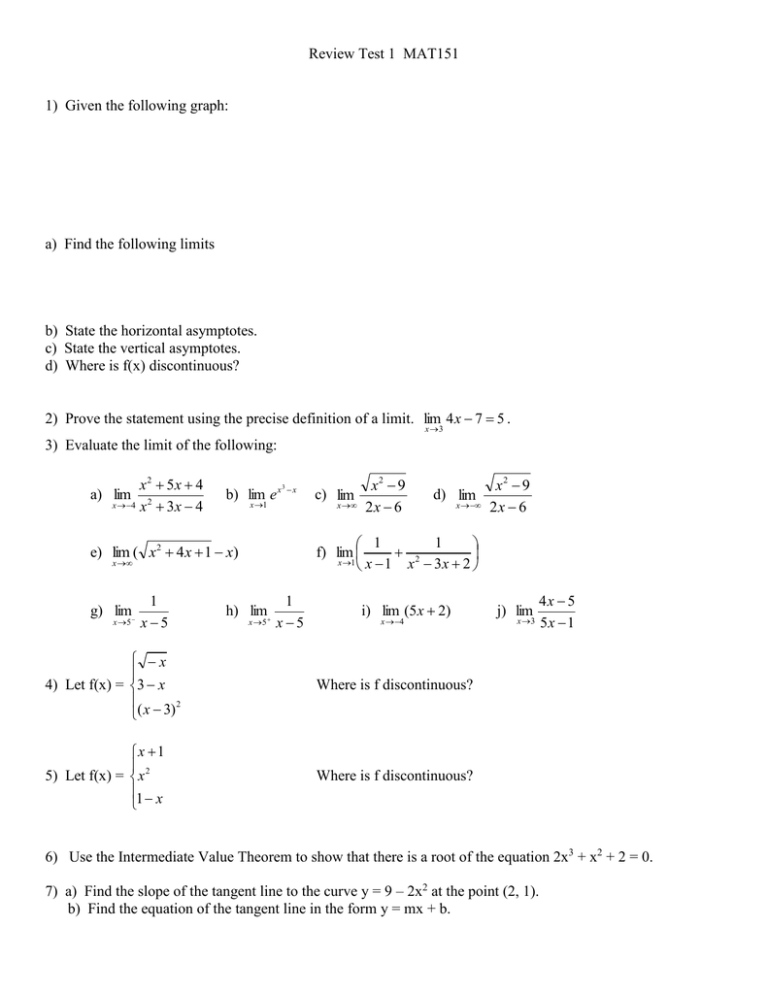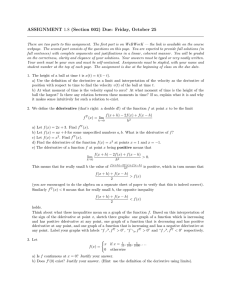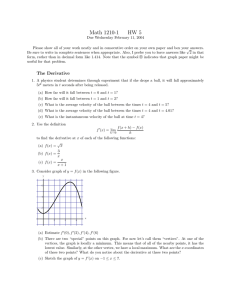Review Test 1 MAT151 1) Given the following graph:
advertisement

Review Test 1 MAT151 1) Given the following graph: a) Find the following limits b) State the horizontal asymptotes. c) State the vertical asymptotes. d) Where is f(x) discontinuous? 2) Prove the statement using the precise definition of a limit. lim 4 x 7 5 . x 3 3) Evaluate the limit of the following: x2 5x 4 x 4 x 2 3 x 4 a) lim b) lim e x 3 x x 1 x x 5 1 x 5 x x2 9 2x 6 d) lim x x2 9 2x 6 1 1 2 f) lim x 1 x 1 x 3x 2 e) lim ( x 2 4 x 1 x) g) lim c) lim h) lim x 5 1 x 5 i) lim (5 x 2) x 4 x 4) Let f(x) = 3 x ( x 3) 2 Where is f discontinuous? x 1 5) Let f(x) = x 2 1 x Where is f discontinuous? 4x 5 x 3 5 x 1 j) lim 6) Use the Intermediate Value Theorem to show that there is a root of the equation 2x3 + x2 + 2 = 0. 7) a) Find the slope of the tangent line to the curve y = 9 – 2x2 at the point (2, 1). b) Find the equation of the tangent line in the form y = mx + b. 8) The displacement (in meters) of an object moving in a straight line is given by s = 1 + 2t + ¼ t2, where t is measured in seconds. Find the instantaneous velocity when t = 1. 9) a) Use the definition of a derivative to find f’(2), where f(x) = x3 – 2x. b) Find an equation of the tangent line to the curve y = x3 – 2x at the point (2, 4). 10) If a ball is thrown into the air with a velocity of 40 ft/s its height in feet t seconds later is given by y = 40t – 16t2. a) What is the instantaneous velocity when t = 2? b) Find the velocity of the ball when t = a? c) When will the ball hit the ground? d) With what velocity will the rock hit the surface? 11) Find the derivative of the function using the definition of derivative. State the domain of the function and the domain of its derivative. f(x) = 5t – 9t2. 12) Determine the number(s) at which f is continuous. f(x) = x3 1 . x2 9 2 x 3 13) Where is f(x) discontinuous? f(x) = 2 x 14) A ball is thrown vertically upward from the ground with an initial velocity of 64 ft/s. If the positive direction of the distance from the starting point is up, the equation of motion is s = −16t2 + 64t. Let t be the number of seconds in the time that has elapsed since the ball was thrown and s be the number of feet in the distance of the ball from the starting point at t seconds. a) Find the instantaneous velocity of the ball at the end of 1 second. Is the ball rising or falling at the end of 1 second? b) Find the instantaneous velocity of the ball at the end of 3 seconds. Is the ball rising or falling at the end of 3 seconds? c) How many seconds does it take the ball to reach its highest point? d) How high will the ball go? e) Find the speed of the ball at the end of 1 second and at the end of 3 seconds. f) How many seconds does it take the ball to reach the ground? g) Find the instantaneous velocity of the ball when it reaches the ground.




